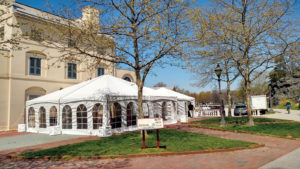
cement ballast. Photo courtesy
of PTG Event Services.
Tent rental companies use IFAI’s ballasting tool to provide accurate amounts of weight, meet code compliance and create a safe experience for event guests.
When it came to calculating weight requirements to anchor commercial tents in the past, rental companies needed some math and science on their side. They typically determined ballasting weights by what Brian Richardson, president of L&A Event Rentals, calls the “‘that should be enough’ guesstimate method.”
In the conversation of tent safety, a best guess isn’t good enough. Fortunately, engineering-driven principles prevailed when IFAI’s Tent Rental Division released its online ballasting tool in 2012. The user-friendly calculator helps tent rental companies select the best methodology for using ballast units to anchor frame tents and clearspan structures.
From a drop-down menu, users choose surface type, ballast type, surface condition and modifier. Then they enter the recommended load from the tent manufacturer, ballast distance from upright and the diameter/size of the ballast.

The ballasting tool formula calculates the required amount of ballast and includes the modifier information. Guidelines recommend how a tent rental company can reach the given amount of ballast and what the effective weight of the ballast is under various conditions.
Although the tool has been around for four years, tent rental companies continue to find it valuable in
accurately and safely ballasting a tent. The following projects illustrate how the online tool delivers straightforward, easy-to-interpret information for even the most challenging ballasting conditions.
Preparation pays off For PTG Event Services, Bethpage, N.Y., proper tent ballasting always has been a part of the business’s DNA.
Nick Deninno, PTG’s owner, was inspired to develop the Block & Roll ballasting system with case studies on PTG’s installations.
“The second the IFAI ballasting tool hit the market, we were using it,” recalls Liz Davis, director of operations at PTG. “It backed up what we knew to be true.”

The tool has allowed the company to develop a ballasting baseline for its inventory over the last four years and easily configure any new additions. Davis has compiled the data derived from the online ballasting calculator into an internal document that she shares with sales staff.
“When they know they are going to be ballasting a particular sized tent, they have a cheat sheet on what to bring to the event,” Davis says.
This cheat sheet proved its worth when PTG had to install and ballast 51 tents totaling 22,000 square feet for a New York City food festival beset with challenging requirements.
Up against a tight turnaround, PTG produced custom branded tents—some with walls and custom floors—that had to be ballasted on grass. Earlier calculations from the online ballasting tool revealed that the event tents called for more than 250,000 pounds of cement.
Transporting such a monumental load can be demanding in the best of conditions. However, the installation team could only do so using a maximum truck length of 34 feet—and on single road access. “When you are bringing in that much cement on trucks that can only accommodate 30,000 pounds apiece,” Davis says, “it’s a tough gig to offload that cement and distribute it on the field, which you are not allowed to drive on if it rains.”
Fortunately, the grass stayed dry, and installers spent 30 hours building the tents and another 18 hours striking them after the event. With the help of the ballasting tool, PTG created a safe, welcoming environment for 9,000 visitors.

two tents at an event in Philadelphia, Pa.,
it also provided documentation to the customer and code enforcers on how the required ballasting was achieved. Photo courtesy of L&A Event Rentals.
In addition to creating a cheat sheet, Davis offers another piece of advice for tent rental companies when determining ballasting needs: “Be mindful of your surface and consider using modifiers to help control the amount of cement needed,” she says.
Philadelphia freedom
A corporate New Year’s Eve event in the Center City area of Philadelphia called for two Eureka! tents measuring 30-by-30 and 20-by-20 feet, respectively. L&A Event Rentals used the online ballasting tool to determine the tents’ weight requirements.

the appropriate amount of weight for anchoring to a variety of types of surfaces and ground conditions. Photo courtesy of PTG Event Services.
Richardson acknowledges that the tool is easy to use, but it did yield one unexpected result. “We were surprised by the difference that the modifier makes,” Richardson says. “For example, adding a rubber mat under the weights lowers the amount of total weight needed.”
Per the ballasting calculator’s recommendations, the company used two 750-pound concrete blocks stacked on top of each other for each tent leg. White vinyl covered the blocks to blend in with the tents.
“The tool is great in providing municipalities and clients the documentation on how proper ballasting should be attained,” Richardson says. “It also assists in demonstrating to clients why your pricing may be higher than a competitor.”
Holly O’Dell is a freelance writer based in Joshua Tree, Calif.
Selecting the best method for anchoring tents depends on a number of factors, including site wind exposure, terrain conditions, tent size and nearby structural obstacles such as trees. Tent rental companies are finding that many sites—whether a corporate parking lot or city park—do not permit staking.
The alternative is to anchor with a ballast, or weight. The most common forms of ballasting are plastic water barrels and concrete blocks. Water barrels have significant drawbacks. Because they are attached from the top about 3 feet off the ground, these drums lose a significant amount of holding power. The barrels have a low friction co-efficient, which reduces their effective weight and thus requires larger quantities in order to ballast. Furthermore, site managers often view barrels as an insurance liability.
“Even though water barrels are filled with 55 gallons of liquid, wind gusts still blow them over and create safety hazards,” says Andrea Jauli, division manager, Tent Rental Division at IFAI. “And they’re not environmentally conducive, especially in places like California where we shouldn’t be filling up hundreds of barrels with water to ballast tents.”
Cement ballasts, on the other hand, have a lower center of gravity and are less likely to slide on concrete or asphalt. “Cement offers more consistent and reliable ballasting with a smaller footprint than water,” says Liz Davis, director of operations at PTG Event Services, Bethpage, N.Y.
A prominent national retail chain scouted five national locations for an event. The biggest caveat: All sites had to be ready for install, even though only one would be selected for the job five days ahead of the event.
In Eugene, Ore., the customer contracted with Special Occasions, Corvallis, Ore., to plan the installation of a 30-by-90-foot tent. The tent needed to be installed in a parking lot, but event organizers did not want to stake the asphalt.
As with any event, Special Occasions also had to prepare for the permitting process. To obtain the correct information about ballasting a tent of this size while complying with local codes, the company turned to IFAI’s online ballasting tool.
The tool was straightforward and accounted for all types of conditions. “In the spring in Oregon, rain is always a probability so we had to factor that into the ballasting tool,” says Kyle Tegner, owner of Special Occasions. “The amount of weight that is required to properly secure a tent of this size is always amazing to me.” For this event, Special Occasions planned on 30,000 pounds of concrete.
As Tegner expected, the tool delivered information critical to the permitting process. “I am finding that if we demonstrate to code enforcement officials our knowledge and willingness to adhere to industry standards, it makes the entire job go a lot easier,” Tegner says.
Unfortunately, the retail chain selected another site to host its event. Even so, use of the ballasting likely would have made the difference between a successful event and one filled with headaches.
“In any installation where a detailed permitting process and ballasting are required, it’s nice to quickly have the credibility and support for our permitting process,” Tegner says.
 TEXTILES.ORG
TEXTILES.ORG


